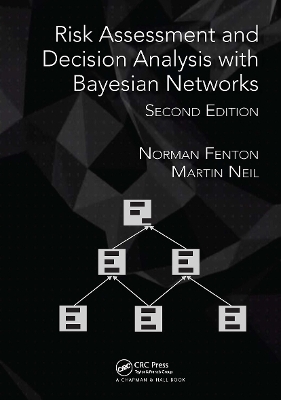
Risk Assessment and Decision Analysis with Bayesian Networks
Chapman & Hall/CRC (Verlag)
978-1-032-91791-7 (ISBN)
Features
Provides all tools necessary to build and run realistic Bayesian network models
Supplies extensive example models based on real risk assessment problems in a wide range of application domains provided; for example, finance, safety, systems reliability, law, forensics, cybersecurity and more
Introduces all necessary mathematics, probability, and statistics as needed
Establishes the basics of probability, risk, and building and using Bayesian network models, before going into the detailed applications
A dedicated website contains exercises and worked solutions for all chapters along with numerous other resources. The AgenaRisk software contains a model library with executable versions of all of the models in the book. Lecture slides are freely available to accredited academic teachers adopting the book on their course.
Norman Fenton is Professor of Risk Information Management in the School of Electronic Engineering and Computer Science at Queen Mary University of London and is also a Director of Agena, a company that specialises in risk management for critical systems. Norman is a mathematician by training who now works on quantitative risk assessment. His experience covers a wide range of application domains such as legal reasoning (he has been an expert witness in major criminal and civil cases), medical analytics, vehicle reliability, embedded software, transport systems, financial services, and football prediction. Norman has a special interest in raising public awareness of the importance of probability theory and Bayesian reasoning in everyday life. Norman has published 7 books and 250 referred articles. Martin Neil is a Professor in Computer Science and Statistics in the School of Electronic Engineering and Computer Science at Queen Mary, University of London and is also a Director and joint founder and of Agena Ltd, who develop and distribute AgenaRisk, a software product for modeling risk and uncertainty. In addition to working on theoretical and algorithmic foundations, his research covers a wide range of application domains including medical analytics, legal reasoning, embedded software, operational risk in finance, systems and design reliability (including software), project risk, commercial risk, decision support, cost benefit analysis, AI and personalization, machine learning, legal argumentation and cyber security. At Queen Mary he teaches decision and risk analysis. Martin was a fellow at the Newton Institute for Mathematical Sciences, Cambridge University in 2016 and was invited to the Fields Institute for Research in Mathematical Sciences, University of Toronto, Canada in 2010. Martin has published over 100 refereed articles.
There Is More to Assessing Risk Than Statistics.
The Need for Causal, Explanatory Models in Risk Assessment.
Measuring Uncertainty: The Inevitability of Subjectivity.
The Basics of Probability.
Bayes’ Theorem and Conditional Probability.
From Bayes’ Theorem to Bayesian Networks.
Defining the Structure of Bayesian Networks.
Building and Eliciting Node Probability Tables.
Numeric Variables and Continuous Distribution Functions.
Hypothesis Testing and Confidence Intervals.
Modeling Operational Risk.
Systems Reliability Modeling.
Bayes and the Law.
Learning Bayesian Networks.
Decision making, Influence Diagrams and Value of information.
Bayesian networks in forensics.
Using Bayesian networks to debunk bad statistics.
Bayesian networks for football prediction.
Appendix A: The Basics of Counting.
Appendix B: The Algebra of Node Probability Tables.
Appendix C: Junction Tree Algorithm.
Appendix D: Dynamic Discretization.
Appendix E: Statistical Distributions.
| Erscheinungsdatum | 16.10.2024 |
|---|---|
| Zusatzinfo | 370 Illustrations, black and white |
| Sprache | englisch |
| Maße | 178 x 254 mm |
| Gewicht | 1220 g |
| Themenwelt | Mathematik / Informatik ► Informatik ► Datenbanken |
| Mathematik / Informatik ► Informatik ► Theorie / Studium | |
| Mathematik / Informatik ► Mathematik | |
| ISBN-10 | 1-032-91791-1 / 1032917911 |
| ISBN-13 | 978-1-032-91791-7 / 9781032917917 |
| Zustand | Neuware |
| Informationen gemäß Produktsicherheitsverordnung (GPSR) | |
| Haben Sie eine Frage zum Produkt? |
aus dem Bereich


